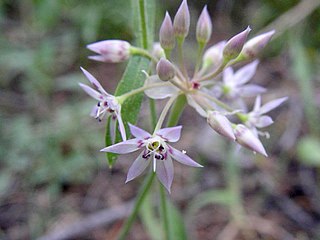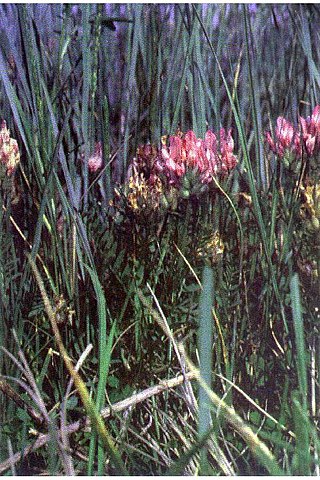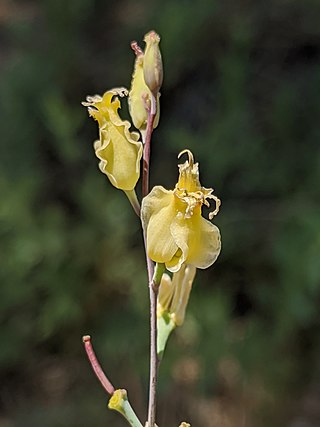
Thunbergia alata, commonly called black-eyed Susan vine, is a herbaceous perennial climbing plant species in the family Acanthaceae. It is native to Eastern Africa, and has been naturalized in other parts of the world.

Allium campanulatum is a species of wild onion known by the common name dusky onion or Sierra onion. This is a flowering plant native to the western United States from southeastern Washington and northern Oregon to southern California, and western Nevada. The dusky onion grows in foothills and mountains, especially in dry areas, such as chaparral habitats.

Elymus glaucus is a species of grass known as blue wild rye or blue wildrye. This grass is native to North America from Alaska to New York to northern Mexico. It is a common and widespread species of wild rye.

Epilobium palustre is a species of willowherb known by the common name marsh willowherb. This plant has a circumboreal distribution, and can be found farther south in mountainous areas.

Juncus confusus is a species of rush known by the common name Colorado rush. It is native to western North America from British Columbia to northern California to Colorado, where it grows in coniferous forests and wet, grassy areas such as mountain meadows. It is a bunching rhizomatous perennial herb which grows to a maximum height between 30 and 50 centimeters. Its thready leaves grow from the base of the light green stems to about 15 centimeters long. The inflorescence atop the stem is an array of individual flowers and there is a long bract at the base which may be up to 8 centimeters in length. Each flower has long, pointed tepals with dark and light longitudinal stripes and membranous, translucent borders. There are six stamens. The fruit is a light to dark brown oval-shaped or rounded capsule.

Allium tuolumnense is a rare species of wild onion, known by the common name Rawhide Hill onion.

Leontodon saxatilis is a species of hawkbit known by the common names lesser hawkbit, rough hawkbit, and hairy hawkbit. It is native to Europe and North Africa but can be found in many other places across the globe as an introduced species and often a noxious weed. This is a dandelion-like herb growing patches of many erect, leafless stems from a basal rosette of leaves. The leaves are 2 to 15 centimeters long, 0.5 to 2.5 centimeters wide, entire or lobed, and green in color. Atop the stems are solitary flower heads which are ligulate, containing layered rings of ray florets with no disc florets. The florets are yellow with toothed tips. The fruit is a cylindrical achene with a pappus of scales. Fruits near the center of the flower head are rough, while those growing along the edges of the head are smooth.

Arabis lemmonii is a species of flowering plant in the family Brassicaceae known by the common name Lemmon's rockcress. It is native to western North America from Alaska to California to Colorado, where it grows in a number of rocky habitat types.

Astragalus agrestis is a species of milkvetch known by the common names purple milkvetch, purple loco, and field milkvetch. It is native to much of western and northern North America from most of Canada to the southwestern United States, as well as eastern Asia. It grows in vernally moist areas such as meadows, and is often found in sagebrush.

Boechera breweri is a species of flowering plant in the family Brassicaceae known by the common name Brewer's rockcress.

Lupinus brevicaulis is a species of lupine known by the common names shortstem lupine and sand lupine. It is native to the southwestern United States, including Oregon, California, Nevada, Utah, Colorado, Arizona, and New Mexico, where it grows in many types of sandy habitat.

Mentzelia albicaulis is a species of flowering plants in the family Loasaceae known by the common names whitestem blazingstar, white-stemmed stickleaf, and small flowered blazing star. It is native to much of western North America, where it grows in mountain, desert, and plateau habitat.

Rudbeckia californica is a species of flowering plant in the family Asteraceae, known by the common name California coneflower.

Setaria verticillata is a species of grass known by the common names hooked bristlegrass, rough bristle-grass and bristly foxtail. It is native to Europe, but it is known on most continents as an introduced species and often a noxious weed. It is a hardy bunchgrass which grows in many types of urban, cultivated, and disturbed habitat. It is a weed of many types of agricultural crops, growing in vineyards and fields. Herbicide-resistant strains have been noted.
Streptanthus barbiger is a species of flowering plant in the mustard family known by the common name bearded jewelflower. It is endemic to California, where it is limited to the North Coast Ranges. It grows in woodlands and chaparral habitat, often on serpentine soils. It is an annual herb producing a branching stem up to about 80 centimeters in maximum height. Leaves near the base of the stem are lance-shaped to oval and pointed, usually with toothed edges, the blades measuring up to 7 centimeters long. Leaves higher on the stem may be longer but are narrower and have smooth edges. Flowers occur at intervals along the upper stem. Each has a spherical to urn-shaped calyx of greenish yellow or purple sepals under a centimeter long. Whitish or purple-tinged petals up to a centimeter long emerge from the tip. The fruit is a long, flat, curving silique which may be 7 centimeters in length.

Streptanthus bernardinus is a species of flowering plant in the mustard family known by the common name Laguna Mountains jewelflower, or Laguna Mountain jewelflower.
Toxicoscordion brevibracteatum is a species of flowering plant known by the common name desert deathcamas. It is native to Baja California, Sonora, and California, where it grows in sandy desert habitat among creosote and Joshua trees.

Eriophorum viridicarinatum is a species of sedge known by the common names thinleaf cottonsedge, green-keeled cottongrass, and bog cottongrass. It is native to northern North America, where it occurs in Alaska and throughout much of Canada, its range extending into the northern contiguous United States. Its distribution is more patchy in the west but it is widespread in eastern Canada.

Leucostele atacamensis (cardón) is a species of cactus from Chile, Argentina and Bolivia. The wood of this species can be used in building and in making furniture.

Encephalartos nubimontanus is a species of cycad which is native to Limpopo, South Africa.

















